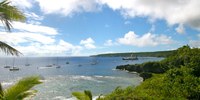South Pacific, Niue: Australian Catamaran Runs Aground on East Coast
In recent weeks the Niue Police Search and Rescue vessel “SAR1” has been deployed a number of times to assist yachts in trouble as they approach Niue. At the end of July both land-based and sea rescue teams kicked into action when an Australian catamaran ran aground on the eastern coast of the Island. Keith Vial, commodore of the Niue Yacht Club, reports.
Published 5 years ago


- View of Niue mooring field courtesy of NYC
In October 2017 the New Zealand Government donated a Search and Rescue vessel to Niue as there was a need for a vessel that could respond quickly to any emergencies at sea.
Since then the Niue Police Department, led by Chief Tony Edwards and well supported by Maritime Services (NZ) and Niue Telecom 24 hour Maritime Radio Service, have enhanced the skills available at the local level.
In recent weeks the Police Search and Rescue vessel “SAR1” has been rapidly deployed by Chief Tony to assist at least two yachts off Niue’s Western coast that had mechanical failure and couldn’t take up moorings without assistance.
Then at 03:00 on Monday 30th July a large catamaran with an Australian couple on board, ran aground on the Eastern coast of Niue – an inhospitable and dangerous coastline.
Within minutes of their EPIRB being activated, the 24 hour Maritime Radio Service and Chief Tony’s local Search and Rescue team assisted by Sidney Lui-Ikiua in association with the Niuean Disaster Management team led by Robin Hekau, were being mobilized to respond.
The Search and Rescue responders were faced with extreme difficulties in getting to the site of the stranded catamaran. Niue’s coastline is 85% reef flat with 15% sheer cliffs topped by formidable forests and dense vegetation.
“SAR1” was deployed and arrived off the reef flat, but because of the sea conditions had to stand off the coastline. Meanwhile the land-based rescue team were carrying the resources and rescue equipment needed through the rough terrain, an energy-sapping and dangerous exercise. Daylight was just breaking when the rescuers reached the cliff edge beneath which the Australian yacht crew were sheltering. Because of the couples’ injuries and exhausted state, evacuation stretchers were needed for the 1km journey back through the difficult terrain to where the ambulance and other support staff were waiting.
The two cruisers were hospitalized on Niue and their injuries attended to. Sidney, from the SAR team, provided clothing and other essential items while the New Zealand High Commission was involved in replacing lost documentation. The High Commission also arranged for the cruisers’ transfer home. Prior to their flight out, they had been accommodated at the local resort with support from Niue Tourism.
While the couple were safe and being cared for, the police team supported by many other Niuean agencies and volunteers were back at the wreck site draining fuel lines and storage tanks into 20-liter jerry cans. This was an important precaution in order to minimize the risk to the reef and coral ecosystems. Over 200 liters of fuel and oils had to be “manhandled” up the cliffs and back through the forest to be disposed of safely.
Other equipment that was salvageable was also removed and again returned to the support base.
Congratulations and a very big thank you to Chief Tony, the Disaster Management leader Robin and a host of other volunteers, for the prompt and effective response to this sad event.
A well trained and resourced team coupled with a dedicated and tough group of professionals and volunteers affected a difficult rescue in dangerous conditions. To then return to minimize environmental damage is a tribute to their endurance and tenacity.
“To protect and serve” is the motto of the Niuean Police. Perhaps “above and beyond” should be included.
Keith Vial
Commodore
Niue Yacht Club
Related to following destinations: Niue
Related to the following Cruising Resources: Incident Reports, Safety, Safety and Medical







Just before we arrived at Niue in 2008 a yacht had gone aground on the SE shore. Most cruisers were using digital charts which didn’t always reflect the notes that were on the paper charts, CM93 charts for example. However, if I recall correctly the position of Niue was displaced about 2nms NW of its true position and the skipper of the yacht that had gone aground reasoned that this was the reason he had hit Niue at night, having planned to pass 2 nms S en route to the anchorage.
The New Zealand Hydrographic Authority have issued a risk assessment (dated 2016) for Niue which states:
“The current nautical charting consists of one approach scale chart of Niue, chart NZ845
(scale 1:150,000) which is a modern metric chart on WGS 84 datum, compatible with satellite
navigation and supported by ENC NZ300845. However this chart shows many areas of broken
contour lines indicating that it is based on old or incomplete survey data. ”
In addition, they add ” It is concerning that there are no navigation landfall lights to
warn vessels of their approach to Niue at night. There are a number of FADs located within the
coastal waters of Niue, these are unlit, not all charted and constitute a navigational hazard near
the island. If a vessel becomes fouled on these devices and disables its propulsion or steering,
then it could contribute to the risk of grounding on the island. The seasonal yacht moorings in
Alofi harbor are also unlit and their extent is not fully shown on the navigational chart.”
Full details of the Risk Assessment can be found at: https://www.iho.int/mtg_docs/CB/CBA/Risk/SWPRHP-Niue-Risk-Assessment-Report.pdf